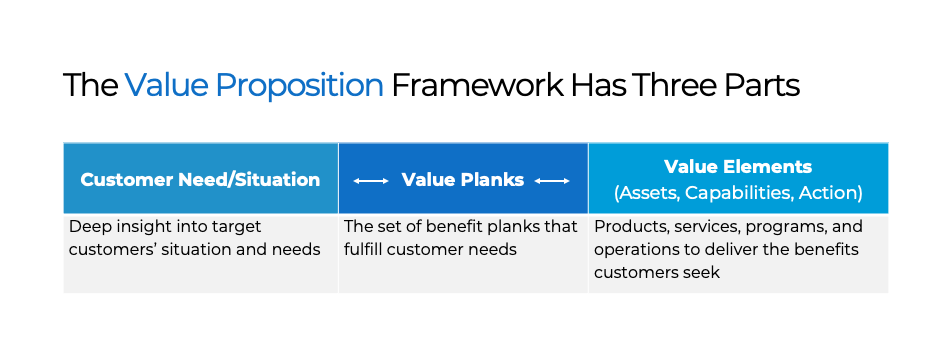Design and Align Value Propositions

The strongest brands and businesses result from a disciplined alignment of initiatives against marketplace requirements. The value proposition (or offering) determines which benefits to stand for and deliver on to align with target customer needs.
What is a value proposition? Structurally, a value proposition typically consists of four to six benefit-based “planks”. Each plank briefly defines what benefit can be derived when the offering is used by core customers (e.g., convenience, peace of mind, comfort, etc.).
The combination of individual benefit “planks” comprises the full value proposition (or value stack) in delivering a relevant and distinctive offering to target customers.
Just like an organization can have multiple brands, and organization can have multiple value stacks, at the corporate, business unit, and product/service levels.
EquiBrand Consulting helps business leaders create a multidimensional definition of value, aligning customer needs, benefit planks, and company operations. We employ creativity and concept iteration to identify new market spaces and then work backward to deliver solutions, resulting in numerous internal and customer benefits.
Value Proposition Framework
A value proposition framework (also called a value proposition canvas) puts customer insight into relevant business operational terms, making it easier to make decisions and develop action plans.
Value proposition design focuses explicitly on customer needs, delivering concrete products and services people buy. At the most basic level, a the framework defines how to win by linking three things—customer needs, benefits sought, and assets and capabilities. When all three parts align, the organization creates and captures value. Let’s take a closer look at each part.

There are three parts to consider in designing a strong proposition :
- Customer Situation: Actionable insights related to the target situation today and in the future
- Value Planks: The set of enduring customer or brand benefit “planks” that fulfill customer needs
- Value Elements: Operational elements required to deliver against desired benefits
Breaking it down, the customer need/situation describes the base-level needs of the target audience. What does your target customer desire? You can obtain customer clarity through a variety of research methods, including in-depth interviews, ethnographic studies, and data analytics.
Value planks, the middle column, define key benefits delivered to the target customer. These can be functional, emotional, or self-expressive benefits, or expressed as jobs to be done.
The final column describes operational components used to deliver on customer needs and benefits sought. This consists of individual value elements—capabilities, competencies, and other assets the organization can provide.
Individual value elements combine to create value planks, which in turn form the total proposition.
To unlock growth, a company can improve existing propositions or create entirely new ones. In some cases, value can be created by combining existing value elements in new ways.
Value Defined – What You Get for What Your Pay
 Value proposition design recognizes two basic ways to win: either lowering cost or differentiating through enhanced benefits. Value is defined by a simple formula, where it equals what you get for what you pay.
Value proposition design recognizes two basic ways to win: either lowering cost or differentiating through enhanced benefits. Value is defined by a simple formula, where it equals what you get for what you pay.
Value is increased either by adding benefits (i.e., value elements or planks) or reducing what customers pay through lower pricing. Often, companies do both—increasing what you get while decreasing what you pay. It typically makes sense to improve value by focusing on “what you get” unless the business is the absolute lowest cost provider.
Though it may seem like value elements are over-emphasized in the examples included below, these are the very things that create compelling propositions. The profile companies are excellent operators and understand customer delight is delivered through the details.
Also, consider that value is determined through the eyes of the customer—whether the benefits are rational or emotional, or tangible or perceived.
Value Proposition Design Issues
Learn more about the benefits a strong value proposition can offer your organization.
Value Stack Design Approach
Designing a new customer value proposition or employee value proposition is like developing a new product, extended to include a broader set of benefits. When fully defined and delivered upon, the value proposition offers the following benefits:
Value Proposition Examples
As you’ll see in the value proposition examples (Amazon, Southwest, Starbucks, and Amazon,) since the propositions tend to be multidimensional, the framework extends beyond a single statement. Think of a value proposition as an offering and not a statement. Also, to make it actionable, the template links customer needs with brand benefits and operational strategies.
In addition, the framework foreshadows the power of upstream marketing integration. Column one relates to insight. Column two to identity—communicable brand benefits. The third column relates to innovation.
When well-constructed, one value proposition element snaps into another like a magnet. As we’ll show, a multiplier effect then occurs as each upstream principle—insight, identity, and innovation— informs and reflects the other.















Follow EquiBrand